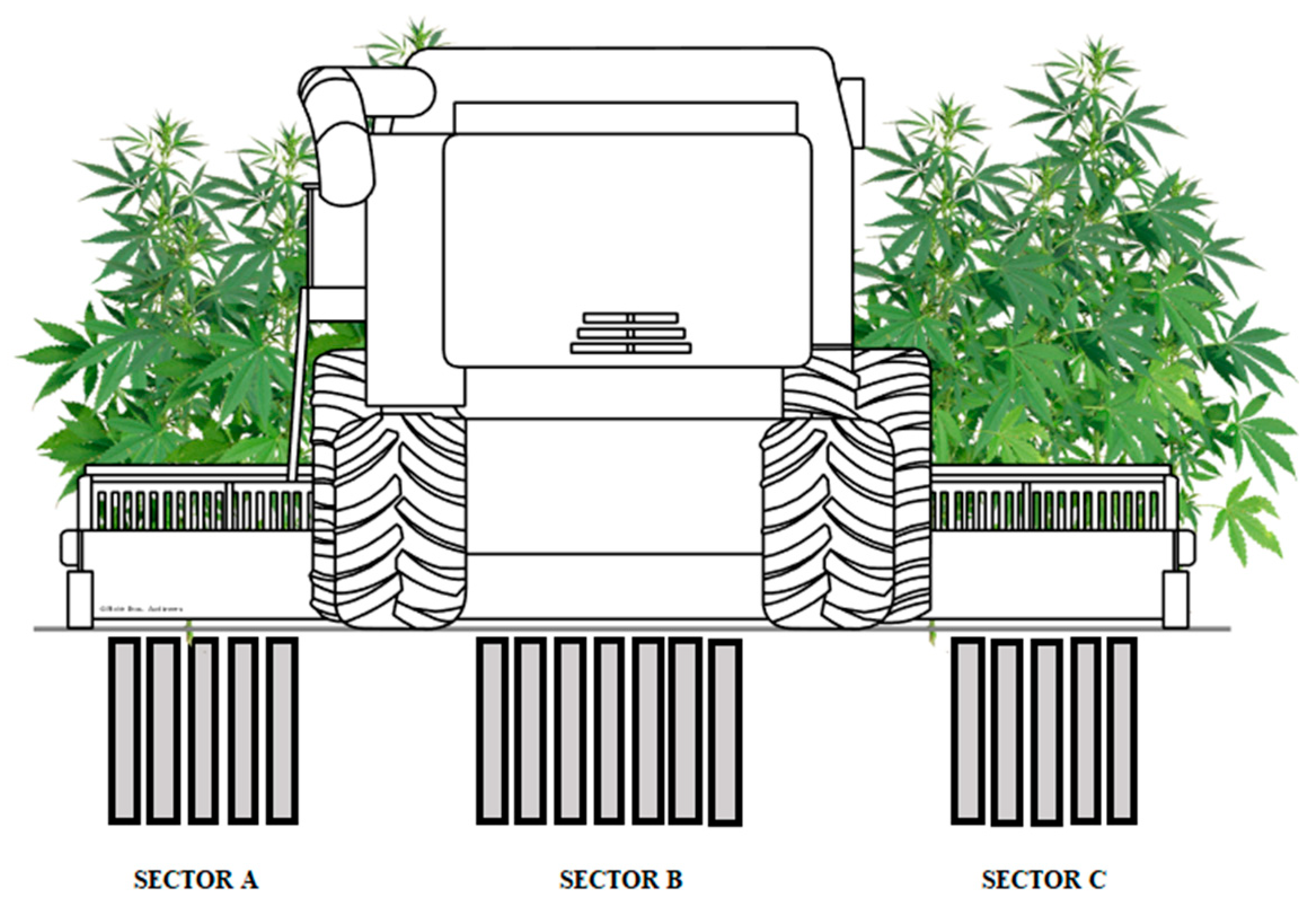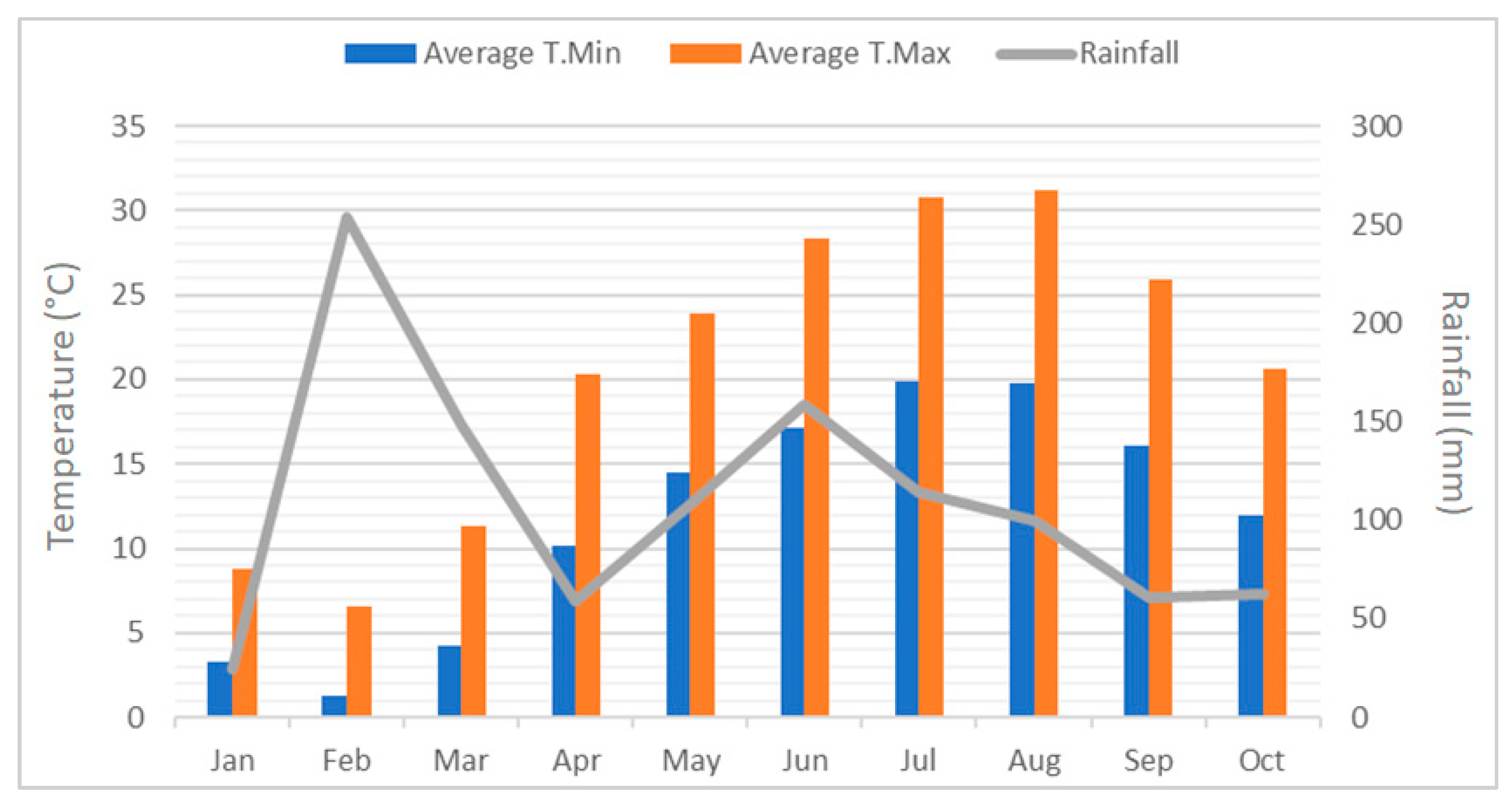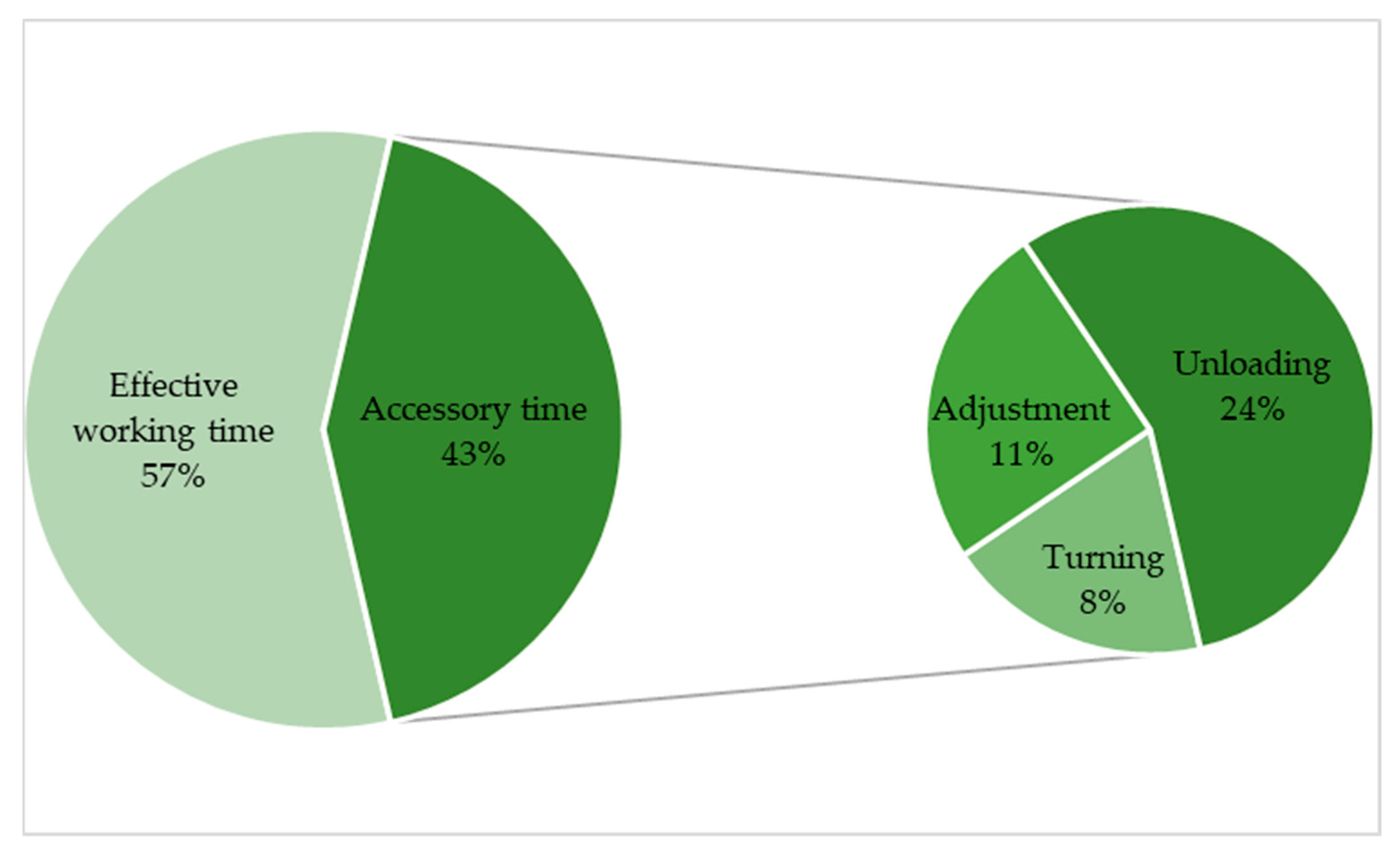Hemp Sowing Seed Production: Assessment of New Approaches in North-Italy
Abstract
1. Introduction
2. Materials and Methods
2.1. Hemp Field
2.2. Harvesting Methods
2.3. Seeds and MOG Preservation
2.4. Statistics
3. Results
3.1. Hemp Field
3.2. Harvesting Performance
3.3. Seeds Losses and MOG Preservation
4. Discussion
5. Conclusions
Author Contributions
Funding
Data Availability Statement
Acknowledgments
Conflicts of Interest
References
- Struik, P.C.; Amaducci, S.; Bullard, M.J.; Stutterheim, N.C.; Venturi, G.; Cromack, H.T.H. Agronomy of Fibre Hemp (Cannahis sativa L.) in Europe. Ind. Crops Prod. 2000, 11, 107–118. [Google Scholar] [CrossRef]
- Tang, K.; Struik, P.C.; Yin, X.; Thouminot, C.; Bjelková, M.; Stramkale, V.; Amaducci, S. Comparing Hemp (Cannabis sativa L.) Cultivars for Dual-Purpose Production under Contrasting Environments. Ind. Crops Prod. 2016, 87, 33–44. [Google Scholar] [CrossRef]
- Tang, K.; Struik, P.C.; Yin, X.; Calzolari, D.; Musio, S.; Thouminot, C.; Bjelková, M.; Stramkale, V.; Magagnini, G.; Amaducci, S. A Comprehensive Study of Planting Density and Nitrogen Fertilization Effect on Dual-Purpose Hemp (Cannabis sativa L.) Cultivation. Ind. Crops Prod. 2017, 107, 427–438. [Google Scholar] [CrossRef]
- Van der Werf, H.M.G.; Turunen, L. The Environmental Impacts of the Production of Hemp and Flax Textile Yarn. Ind. Crops Prod. 2008, 27, 1–10. [Google Scholar] [CrossRef]
- Michael, C. European Hemp Industry: Cultivation, Processing and Applications for Fibres, Shivs, Seeds and Flowers. European Industrial Hemp Association. 2017, 1994, 1–9. [Google Scholar]
- Pari, L.; Baraniecki, P.; Kaniewski, R.; Scarfone, A. Harvesting Strategies of Bast Fiber Crops in Europe and in China. Ind. Crops Prod. 2014, 68, 90–96. [Google Scholar] [CrossRef]
- Giupponi, L.; Leoni, V.; Carrer, M.; Ceciliani, G.; Sala, S.; Panseri, S.; Pavlovic, R.; Giorgi, A. Overview on Italian Hemp Production Chain, Related Productive and Commercial Activities and Legislative Framework. Ital. J. Agron. 2020, 15, 194–205. [Google Scholar] [CrossRef]
- Baraniecki, P.; Latterini, F.; Stefanoni, W.; Frankowski, J.; Wielgusz, K.; Pari, L. Assessment of the Working Performance of an Innovative Prototype to Harvest Hemp Seed in Two Different Conditions of Terrain Slope. Agronomy 2022, 12, 185. [Google Scholar] [CrossRef]
- Faugno, S.; Piccolella, S.; Sannino, M.; Principio, L.; Crescente, G.; Baldi, G.M.; Fiorentino, N.; Pacifico, S. Can Agronomic Practices and Cold-Pressing Extraction Parameters Affect Phenols and Polyphenols Content in Hempseed Oils? Ind. Crops Prod. 2019, 130, 511–519. [Google Scholar] [CrossRef]
- Baldini, M.; Ferfuia, C.; Piani, B.; Sepulcri, A.; Dorigo, G.; Zuliani, F.; Danuso, F.; Cattivello, C. The Performance and Potentiality of Monoecious Hemp (Cannabis sativa L.) Cultivars as a Multipurpose Crop. Agronomy 2018, 8, 162. [Google Scholar] [CrossRef]
- Baldini, M.; Ferfuia, C.; Zuliani, F.; Danuso, F. Suitability Assessment of Different Hemp (Cannabis sativa L.) Varieties to the Cultivation Environment. Ind. Crops Prod. 2020, 143, 111860. [Google Scholar] [CrossRef]
- Salentijn, E.M.J.; Zhang, Q.; Amaducci, S.; Yang, M.; Trindade, L.M. New Developments in Fiber Hemp (Cannabis sativa L.) Breeding. Ind. Crops Prod. 2015, 68, 32–41. [Google Scholar] [CrossRef]
- Faugno, S.; Sannino, M.; Crimaldi, M.; Caracciolo, G.; Assirelli, A. Hemp Seed Mechanical Harvesting Efficiency Analysis. In Proceedings of the 26th European Biomass Conference and Exhibition, Copenhagen, Denmark, 14–18 May 2018; pp. 14–17. [Google Scholar]
- Assirelli, A.; Re, L.D.; Esposito, S.; Cocchi, A.; Santangelo, E. The Mechanical Harvesting of Hemp Using In-Field Stand-Retting: A Simpler Approach Converted to the Production of Fibers for Industrial Use. Sustainability 2020, 12, 8795. [Google Scholar] [CrossRef]
- Ferfuia, C.; Zuliani, F.; Danuso, F.; Piani, B.; Cattivello, C.; Dorigo, G.; Baldini, M. Performance and Stability of Different Monoecious Hemp Cultivars in a Multi-Environments Trial in North-Eastern Italy. Agronomy 2021, 11, 1424. [Google Scholar] [CrossRef]
- Faux, A.M.; Draye, X.; Lambert, R.; d’Andrimont, R.; Raulier, P.; Bertin, P. The Relationship of Stem and Seed Yields to Flowering Phenology and Sex Expression in Monoecious Hemp (Cannabis sativa L.). Eur. J. Agron. 2013, 47, 11–22. [Google Scholar] [CrossRef]
- Chen, Y.; Liu, J. Development of a Windrower for Dual-Purpose Hemp (Cannabis sativa). Can. Biosyst. Eng. Genie Biosyst. Can. 2003, 45, 2.1–2.7. [Google Scholar]
- Fike, J. Industrial Hemp: Renewed Opportunities for an Ancient Crop. CRC Crit. Rev. Plant Sci. 2016, 35, 406–424. [Google Scholar] [CrossRef]
- Globerson, D.; Sharir, A.; Eliasi, R. The Nature of Flowering and Seed Maturation of Onions as a Basis for Mechanical Harvesting of the Seeds. Acta Hortic. 1981, 111, 99–108. [Google Scholar] [CrossRef]
- Assirelli, A.; Santangelo, E.; Brambilla, M.; Bisaglia, C.; Civitarese, V.; Caracciolo, G.; Spinelli, R. Techniques for the Transportation of Complete-Trees from the Termination of Peach Orchards. Biomass Bioenergy 2019, 130, 105378. [Google Scholar] [CrossRef]
- Del Giudice, A.; Assirelli, A.; Gallucci, F.; Bellacima, R.; Pari, L.; Santangelo, E. Production of Energy Feedstock from the Riparian Vegetation of Arundo donax (L.): Suitability of the Chopping Systems. Ecol. Eng. 2017, 102, 459–467. [Google Scholar] [CrossRef]
- Assirelli, A.; Santangelo, E.; Spinelli, R.; Acampora, A.; Croce, S.; Civitarese, V.; Pari, L. Mechanization of Rhizome Extraction in Giant Reed (Arundo donax L.) Nurseries. Appl. Eng. Agric. 2013, 29, 489–494. [Google Scholar]
- Assirelli, A. Inserto Macchine Agricole Colture Da Seme: Il Punto Sulla Meccanizzazione. Riv. Agric. 2004, 10, 104–108. [Google Scholar]
- Westerhuis, W.; Struik, P.C.; Van Dam, J.E.G.; Stomph, T.J. Postponed Sowing Does Not Alter the Fibre/Wood Ratio or Fibre Extractability of Fibre Hemp (Cannabis sativa). Ann. Appl. Biol. 2009, 155, 333–348. [Google Scholar] [CrossRef]
- ASAE EP497.7; Agricultural Machinery Management. ASABE: Saint Joseph, MI, USA, 2011.
- Reith, S.; Frisch, J.; Winkler, B. Revision of the Working Time Classification to Optimize Work Processes in Modern Agriculture. Chem. Eng. Trans. 2017, 58, 121–126. [Google Scholar] [CrossRef]
- Rules for Testing Seeds. J. Seeds Technol. 1993, 16, 1–113. Available online: https://www.jstor.org/stable/i23432702 (accessed on 8 December 2022).
- Pari, L.; Assirelli, A.; Suardi, A.; Civitarese, V.; Del Giudice, A.; Costa, C.; Santangelo, E. The Harvest of Oilseed Rape (Brassica napus L.): The Effective Yield Losses at on-Farm Scale in the Italian Area. Biomass Bioenergy 2012, 46, 453–458. [Google Scholar] [CrossRef]
- Musio, S.; Müssig, J.; Amaducci, S. Optimizing Hemp Fiber Production for High Performance Composite Applications. Front. Plant Sci. 2018, 9, 1702. [Google Scholar] [CrossRef]
- Zatta, A.; Monti, A.; Venturi, G. Eighty Years of Studies on Industrial Hemp in the Po Valley (1930–2010). J. Nat. Fibers 2012, 9, 180–196. [Google Scholar] [CrossRef]
- Tsaliki, E.; Kalivas, A.; Jankauskiene, Z.; Irakli, M.; Cook, C.; Grigoriadis, I.; Panoras, I.; Vasilakoglou, I.; Dhima, K. Fibre and Seed Productivity of Industrial Hemp (Cannabis sativa l.) Varieties under Mediterranean Conditions. Agronomy 2021, 11, 171. [Google Scholar] [CrossRef]
- Pari, L.; Alfano, V.; Acampora, A.; Del Giudice, A.; Scarfone, A.; Sanzone, E. Harvesting and Separation of Different Plant Fractions in Cynara cardunculus L. In Perennial Biomass Crops for a Resource-Constrained World; Barth, S., Murphy-Bokern, D., Kalinina, O., Taylor, G., Jones, M., Eds.; Springer International Publishing: Cham, Switzerland, 2016; p. 313. [Google Scholar] [CrossRef][Green Version]
- Pari, L.; Alfano, V.; Scarfone, A. An Innovative Harvesting Sysytem for Multipurpose Hemp. Eur. Biomass Conf. Exhib. Proc. 2016, 2016, 356–358. [Google Scholar]
- Gusovius, H.J.; Hoffmann, T.; Budde, J.; Lühr, C. Still Special? Harvesting Procedures for Industrial Hemp. Landtechnik 2016, 71, 14–24. [Google Scholar] [CrossRef]
- Burton, R.A.; Andres, M.; Cole, M.; Cowley, J.M.; Augustin, M.A. Industrial Hemp Seed: From the Field to Value-Added Food Ingredients. J. Cannabis Res. 2022, 4, 45. [Google Scholar] [CrossRef] [PubMed]
- Brăcăcescu, C.; Nedelcu, A.; Cristea, O.-D.; Zaica, A. Considerations on the Importance of the Conditioning of Industrial Hemp Seeds. Acta Tech. Corviniensis 2022, 15, 93–96. [Google Scholar]
- Suriyong, S.; Krittigamas, N.; Pinmanee, S.; Punyalue, A.; Vearasilp, S. Influence of Storage Conditions on Change of Hemp Seed Quality. Agric. Agric. Sci. Procedia 2015, 5, 170–176. [Google Scholar] [CrossRef]
- Small, E.; Brookes, B. Temperature and Moisture Content for Storage Maintenance of Germination Capacity of Seeds of Industrial Hemp, Marijuana, and Ditchweed Forms of Cannabis sativa. J. Nat. Fibers 2012, 9, 240–255. [Google Scholar] [CrossRef]
- Oseyko, M.; Sova, N.; Chornei, K. Substantiation of Hemp Seeds Storage and Processing Technologies for Functional, Dietary and Specialty Products. Review. Ukranian Food J. 2021, 10, 427–646. [Google Scholar] [CrossRef]




| Parameters | Value |
|---|---|
| Model | New Holland CR 9080 |
| Engine power in kW | 380 |
| Rotor diameter in mm | 559 |
| Rotor length in mm | 2638 |
| Rotor speed in rpm | 750 |
| Fan Speed in rpm | 660 |
| Concave clearance in mm | 45 |
| Upper sieve clearance in mm | 9 |
| Lower sieve clearance in mm | 5 |
| Header Model | DBF TI |
| Rows (n°) | 12 |
| Length in m | 5.75 |
| Picker type | belts |
| Mower type | disc |
| Weight in kg | 1950 |
| Parameters | Value |
|---|---|
| Engine | |
| Make/Model | CIMME X68 006330 E4 RD |
| Engine power in kW | 7.5 |
| Rotor speed in rpm | 1450 |
| Flow rate range in m3 min−1 | 125–355 |
| Temperature range in °C | 15–80 |
| Heat generator | |
| Model | Tecflam VDME30LM |
| Fuel type | LPG |
| Heat power in kcal h−1 | 180,000 |
| Pressure in mbar | 300 |
| Low calorific value in kcal | 2300 |
| Output max in N m3 h−1 | 8 |
| Generator’s fan | |
| Power engine in kW | 0.37 |
| Rotor speed in rpm | 2805 |
| Parameter | U.M. | Average | Standard Deviation |
|---|---|---|---|
| Plant density | (n. m−2) | 71.3 | 24.0 |
| Plant height | (cm) | 173.33 | 11.8 |
| Total fresh biomass yield | (Mg ha−1) | 18.8 | 3.3 |
| Infructescence fresh weight | (Mg ha−1) | 6.4 | 0.4 |
| Moisture content of the infructescence | (%) | 64.2 | 1.0 |
| Seed yield | (Mg ha−1 FW) | 2.0 | 0.2 |
| Moisture content of the seed | (%) | 24.8 | 2.0 |
| Seed yield | (Mg ha−1 DW) | 1.5 | 0.1 |
| Seeds > 2 mm | (%) | 77.7 | 3.4 |
| Seeds < 2 mm | (%) | 11.0 | 2.6 |
| Impurity | (%) | 11.3 | 1.0 |
| Seed (>2 mm) yield | (Mg ha−1 DW) | 1.14 | 0.16 |
| Dry weight of 1000 seeds | (g) | 15.9 | 0.7 |
| Natural dehiscence on the 5th of October | 248.0 ± 32.2 |
| Natural dehiscence on the 25th of October | 590.6 ± 210.3 |
| Harvester’s dehiscence on the 25th of October | |
| Sector A | 34.8 ± 1.2 b |
| Sector B | 39.3 ± 0.9 a |
| Sector C | 35.0 ± 2.2 b |
| Mean | 36.0 ± 2.8 |
Publisher’s Note: MDPI stays neutral with regard to jurisdictional claims in published maps and institutional affiliations. |
© 2022 by the authors. Licensee MDPI, Basel, Switzerland. This article is an open access article distributed under the terms and conditions of the Creative Commons Attribution (CC BY) license (https://creativecommons.org/licenses/by/4.0/).
Share and Cite
Assirelli, A.; Santangelo, E.; Stagno, F.; Roccuzzo, G.; Musio, S.; Amaducci, S. Hemp Sowing Seed Production: Assessment of New Approaches in North-Italy. Sustainability 2022, 14, 17020. https://doi.org/10.3390/su142417020
Assirelli A, Santangelo E, Stagno F, Roccuzzo G, Musio S, Amaducci S. Hemp Sowing Seed Production: Assessment of New Approaches in North-Italy. Sustainability. 2022; 14(24):17020. https://doi.org/10.3390/su142417020
Chicago/Turabian StyleAssirelli, Alberto, Enrico Santangelo, Fiorella Stagno, Giancarlo Roccuzzo, Salvatore Musio, and Stefano Amaducci. 2022. "Hemp Sowing Seed Production: Assessment of New Approaches in North-Italy" Sustainability 14, no. 24: 17020. https://doi.org/10.3390/su142417020
APA StyleAssirelli, A., Santangelo, E., Stagno, F., Roccuzzo, G., Musio, S., & Amaducci, S. (2022). Hemp Sowing Seed Production: Assessment of New Approaches in North-Italy. Sustainability, 14(24), 17020. https://doi.org/10.3390/su142417020







